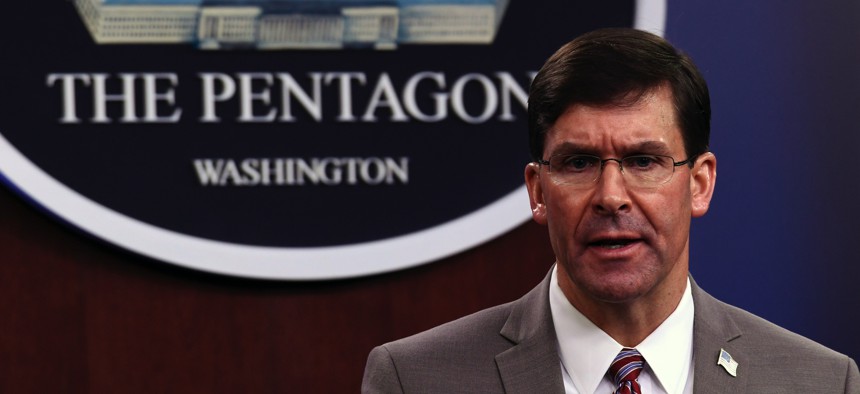
Defense Secretary Mark Esper speaks during a briefing at the Pentagon in Washington, Monday, March 2, 2020. AP / Susan Walsh
Esper’s Reforms: An Interim Report Card
What progress has the defense secretary made on his ambitious goals to reorient the Defense Department?
It’s tough to be secretary of defense. It’s even tougher to be one for this president, who with a single tweet can upend months and years of careful Pentagon planning, overrule his own executives without their input, and change controversial policies on any issue, no matter how small, in an instant. He can even embarrass or undermine you while you’re trying to run the world’s strongest military.
To his credit, Defense Secretary Mark Esper has accomplished much of what he set out to do behind the scenes and without much fanfare—on top of a global pandemic. The secretary, who took office 15 months ago, has spent the past year attempting to shift 1) dollars, 2) people, and 3) tasks toward his department’s top challenge: long-term competition with China. Esper gets high marks for the first objective, notable progress in the second, and his successor will have to duke it out with the bureaucracy regarding the third.
Money. Esper extended his “night court” review process across the defense enterprise, including to combatant commands. The savings manifest from these efficiency drills are respectable. And no “reform” was considered too small or too controversial by this secretary. For example, the department used to print so many extra paper maps that they took up the equivalent of five Pentagon courtyards of warehouse space. Now, maps are printed as needed, saving money and freeing up real estate for more worthy needs.
Esper even considered very modest reductions over five years to the military health system that would have come over with next year’s budget in the spring. While Trump promptly killed that internal deliberation of a $2.2 billion reduction, its mere consideration shows the seriousness of his effort to better align dollars with strategy.
On a bigger scale, the services are all moving money to better implement the National Defense Strategy. Just last week, Navy Secretary Kenneth Braithwaite told USNI News that he’s “done a deep-dive into the budget and found tens of billions of dollars in cuts” that will help pay for the new 500-ship fleet endorsed by the defense secretary.
In the budget for this fiscal year, Esper requested historic levels of research and development funding for new technologies such as artificial intelligence, hypersonic weapons, directed energy, and 5G networks. The Navy awarded a contract for a new class of frigates, the Maritime Security Initiative has provided $400 million in allied assistance in Asia, and all the services oversaw manned-unmanned teaming in new high-tech experiments.
People. Esper has also been busy putting like-minded thinkers in charge when given the opportunity. In August, the new Air Force chief of staff, Gen. CQ Brown, released guidance titled “Accelerate Change or Lose.” In it, Brown agrees that winning the long-term competition will require “ruthless prioritization,” which means identifying impediments to change and reducing redundancies across the services, such as air base defense and deep strike capability.
Marine Corps Commandant Gen. David Berger has gone even further with his Force Design 2030, which orders up six major capability changes to better focus on China. While controversial, his plans also drew wide acclaim for their candor and his willingness to “gore a few sacred cows.”
While Esper has valiantly tried to reorient the entire defense workforce toward the strategy, this is the hardest hurdle to overcome in a bureaucracy of this size. The secretary opened a new China policy office, established a China Strategy Management Group to better integrate efforts, and directed the National Defense University to dedicate half of its coursework to the PRC, thereby making the People’s Liberation Army the pacing threat in all defense schools, programs, and training.
Another handicap has been the high turnover and many vacancies in senior political positions, which partly explain why the Department has yet to complete and send to Congress several key documents, including the 30-year shipbuilding plan, new Navy force structure assessment, and new joint operational concept — all of which may be obsolete by the coming election, new Congress, and budget cycle.
Tasks. Esper has begun to tackle the true source of the tasks challenge by clean-sheet reviewing the regional combatant commands, but his successor will have to work hard to drive any progress forward and solidify its true shift to competition. The next secretary will also need to oversee a real roles-and-missions review, in part to get at the insatiable demands by combatant commands for forces for peacetime training, assurance and deterrence missions all over the world each day.
Services are conducting missions of lesser importance when they should be using this time to regenerate combat power, develop leap-ahead technologies, and refine still-nascent operational concepts. For example, earlier this year Esper oversaw the doubling of military resources to U.S. Southern Command for drug interdiction. Additional assets deployed included Navy destroyers and littoral combat ships, Navy and Air Force patrol and ISR aircraft, helicopters, and even a Security Forces Assistance Brigade company. This kind of firepower “is expensive for counterdrug operations — and is not the most effective, either.” When you’re “not expecting drug runners to have torpedoes” in the words of Bryan Clark at Hudson Institute, less expensive resources can and should be used for these types of missions, especially with a Navy currently pushed to the brink. U.S. warships are out on record-long deployments with shorter rest and training periods upon coming home. In 2015, the Navy reported that it couldn’t meet even half of combatant commands’ requests for forces, and the trend has since only worsened.
Conclusion
While all this was going on, Esper oversaw the standing up of a new military service in the Space Force and managed a global pandemic response operation by the Defense Department involving more than 60,000 uniformed and civilian personnel during the same time as U.S. service members were “serving in more than 100 nations deterring enemies, reassuring allies and building capabilities.”
Esper stayed committed to his ten targeted goals—each with subtasks—under these three broad objectives to begin achieving “irreversible implementation” of the National Defense Strategy. He has made laudable progress — while leaving plenty of work for next year.
NEXT STORY: The Coming F-35 Fiasco




